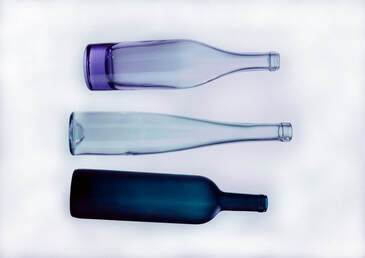Module 2200
Spectroscopy: Overview and preview
Interaction of radiations and stuffs
Absorption of radiation by stuffs, emission of radiation from stuffs
What is the nature of radiation?
Why are those particular wavelengths of radiation absorbed?
Where does the energy of absorbed radiation go?

These bottles appear blue to us because red and yellow light have been absorbed by the glass from light coming from behind toward our eyes. Why were these particular colours absorbed, and blue and green transmitted? Where did the energy of the absorbed light go? What is light (or any form of radiation) anyway?
Overview
Scientists can deduce evidence about the nature of matter by analysis of the particular wavelengths of electromagnetic radiation that are absorbed by materials.
Other evidence can be deduced from the particular wavelengths of radiation that are emitted by materials when subjected to high electric potential or heating - such as the colours emitted by substances in the flames in the banner image above.
This field of science is called spectroscopy.
The study of the interaction of electromagnetic radiation with matter can extend from very high-energy waves (high frequencies and short wavelengths) such as gamma rays and X-rays to very low-energy waves (low frequencies and long wavelengths) such as microwaves.
These include, but go way beyond, radiation in the visible spectrum - those wavelengths which our eyes detect as coloured light from violet to red.
These include, but go way beyond, radiation in the visible spectrum - those wavelengths which our eyes detect as coloured light from violet to red.
Interactions of matter with different regions of the total spectrum provide evidence about different aspects of the nature of matter related to, for example, the energies of electrons, the energies of vibrations of parts of molecules, and the energies of rotation (tumbling) of molecules.
These, in turn, provide evidence about the structures of atoms and molecules.
These, in turn, provide evidence about the structures of atoms and molecules.
Spectroscopic evidence derived from the interaction of matter with all wavelengths of radiation depend upon a phenomenon way out of our daily experience: that is, that the various forms of energy of matter are quantised. This means that energy cannot be changed continuously: it can only have certain levels (and not amounts of energy in between the "allowed" levels). What an extraordinary thing to contemplate!
Spectra (both emission and absorption) in the visible and ultraviolet regions of electromagnetic radiation are attributed to "transitions" between "allowed" levels of energy of electrons, while spectra in the infrared region are due to "transitions" between levels of energy of vibrations in molecules. Prof Bob gives a general explanation in Module 2201: Quantization of forms of energy.
What is light: waves, particles, or neither?
Some of the properties of radiations are consistent with them being waveforms.
However, the notion that species can absorb only particular wavelengths of radiation whose energies corresponds with the differences between levels of forms of energy is only sensible if the radiation is composed of particles (“photons”).
Light is what it is: and not a waveform and a particle, nor a waveform or a particle. Because or our inability to understand the mysterious nature of light, based on our common experiences of phenomena, scientists use a “dual nature of explanations”.
Join in a conversation with Prof Bob in Module 2202: Light: Wave-particle “duality”.
Some of the properties of radiations are consistent with them being waveforms.
However, the notion that species can absorb only particular wavelengths of radiation whose energies corresponds with the differences between levels of forms of energy is only sensible if the radiation is composed of particles (“photons”).
Light is what it is: and not a waveform and a particle, nor a waveform or a particle. Because or our inability to understand the mysterious nature of light, based on our common experiences of phenomena, scientists use a “dual nature of explanations”.
Join in a conversation with Prof Bob in Module 2202: Light: Wave-particle “duality”.
Using a view of light as photons, Prof Bob discusses a more detailed explanation pertaining specifically to absorption of radiations in the visible and ultraviolet in Module 2203: UV-visible spectroscopy.
What does the fraction of light of a particular wavelength that is absorbed (or transmitted) by a coloured solution depend on? The dependence is expressed quantitatively by Beer's law (sometimes called the Beer-Lambert law).
In Module 2204: Beer's law, Prof Bob demonstrates the basis of Beer's law through a simple activity, and shows how it can be used to analyse for the concentration of a coloured component in solution.
In Module 2204: Beer's law, Prof Bob demonstrates the basis of Beer's law through a simple activity, and shows how it can be used to analyse for the concentration of a coloured component in solution.
Finding your way around .....
You can browse or search the Aha! Learning chemistry website in the following ways:
You can browse or search the Aha! Learning chemistry website in the following ways:
- Use the drop-down menus from the buttons at the top of each page to browse the modules chapter-by-chapter.
- Click to go to the TABLE OF CONTENTS (also from the NAVIGATION button) to see all available chapters and modules in numbered sequence.
- Click to go to the ALPHABETICAL INDEX. (also from the NAVIGATION button).
- Enter a word or phrase in the Search box at the top of each page.

